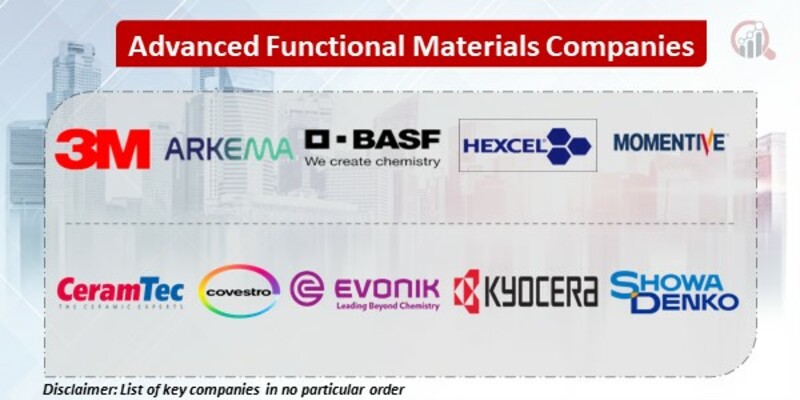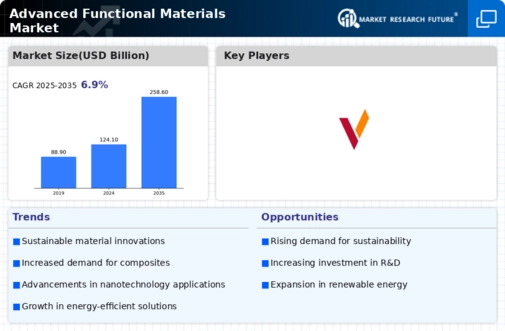Top Industry Leaders in the Advanced Functional Materials Market
 The advanced functional materials market represents the future of innovation across various industries. From high-performance electronics to self-healing composites, these materials possess unique properties that unlock new possibilities. However, navigating this dynamic landscape requires understanding the diverse players, their strategies, and the factors shaping their success. Here's a deeper dive into this market, exploring its key actors, their approaches, and the forces impacting their growth.
The advanced functional materials market represents the future of innovation across various industries. From high-performance electronics to self-healing composites, these materials possess unique properties that unlock new possibilities. However, navigating this dynamic landscape requires understanding the diverse players, their strategies, and the factors shaping their success. Here's a deeper dive into this market, exploring its key actors, their approaches, and the forces impacting their growth.
A Spectrum of Players Driving Innovation:
-
Global Giants: Industry leaders like BASF (Germany), DuPont (US), Merck (Germany), 3M (US), and Evonik (Germany) dominate the market with extensive R&D capabilities, diverse product portfolios, and global reach. -
Regional Champions: Companies like Toray Industries (Japan), Sumitomo Chemical (Japan), and Samsung SDI (South Korea) cater to specific regional needs and offer cost-competitive solutions. -
Niche Innovators: Smaller players such as Nano Dimension (Israel), Graphene Flagship (Europe), and Vorbeck Materials (US) focus on cutting-edge materials like nanomaterials and graphene, pushing the boundaries of functionality.
Strategies for Shaping the Future:
-
Research and Development: Continuous investment in R&D is crucial for developing new materials and staying ahead of the competition. Collaborations with academic institutions and research labs further accelerate innovation. -
Sustainability: Addressing environmental concerns is a growing priority. Players are focusing on bio-based materials, closed-loop manufacturing, and reduced energy consumption. -
Vertical Integration: Integrating upstream raw material production and downstream application development ensures control over quality and cost, and opens up new market opportunities. -
Geographical Expansion: Establishing production facilities in emerging markets with rapid technological advancements and growing demand presents significant growth potential. -
Strategic Partnerships: Collaborations with end-user industries, technology providers, and distributors facilitate tailored solutions, wider market reach, and efficient access to resources.
Factors Shaping the Competitive Landscape:
-
Technological Advancements: Breakthroughs in nanotechnology, biotechnology, and artificial intelligence drive the development of next-generation materials with superior properties. -
Government Initiatives: Support for research and development, coupled with regulations promoting sustainability, influence market dynamics and create new opportunities. -
End-User Industry Trends: Growing demand for high-performance electronics, healthcare technologies, and sustainable solutions shapes the development and application of functional materials. -
Cost Competitiveness: Balancing advanced functionalities with affordability is crucial for wider adoption, especially in cost-sensitive sectors. -
Intellectual Property: Securing strong patent protection for innovative materials is essential for maintaining a competitive edge and capturing market share.
Key companies in the advanced functional materials market include
3M
Arkema
BASF SE
CeramTec GmbH
Covestro AG
Evonik Industries AG
Hexcel Corporation
KYOCERA Corporation
Momentive
SHOWA DENKO K.K.
Sumitomo Chemical Co., Ltd.
Emeren
Recent Developments:
-
August 2023: BASF unveils a new self-healing polymer composite for automotive applications, offering improved durability and reduced maintenance costs. -
September 2023: DuPont announces a partnership with a leading medical device manufacturer to develop biocompatible materials for next-generation implants. -
October 2023: Merck invests in a startup specializing in 3D printing of advanced functional materials, expanding its capabilities in additive manufacturing. -
November 2023: 3M launches a new line of conductive polymers for flexible electronics, targeting the rapidly growing wearable technology market. -
December 2023: Evonik partners with a recycling company to develop innovative methods for recovering and reusing rare earth elements used in functional materials.

